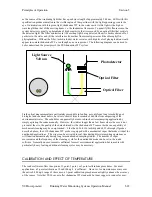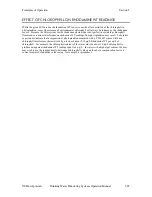
Principles of Operation
Section 5
YSI Incorporated Drinking Water Monitoring Systems Operation Manual
5-11
Ammonium ions and free ammonia are in equilibrium in any solution according to the following equation:
NH
4
+
NH
3
+ H
+
The value of the equilibrium constant associated with this reaction, K = [NH
3
][H
+
]/[NH
4
+
], and its variation
with temperature and salinity, is well known. This information allows the free ammonia concentration
[NH
3
] to be automatically calculated by the sonde software and displayed if this parameter is activated.
Despite the potential problems with interference when using ISEs, it is important to remember that almost
all interfering species produce an artificially high ammonium reading. Thus, if the sonde indicates the
presence of only small quantities of ammonium, it is unlikely that the reading is erroneously low because of
interference. Unusually high ammonium readings (which could be due to interfering ions) should be
confirmed by laboratory analysis after collection of water samples.
Of all the sensors available on the sonde, ion selective electrodes have the greatest tendency to exhibit
calibration drift over time. This drift should not be a major problem for sampling studies where the
instrument can be frequently calibrated. However, if an ammonium sensor is used in a longer-term
deployment study with the sonde, the user should be aware that drift is almost certain to occur. The extent
of the drift will vary depending on the age of the probe, the flow rate at the site, and the quality of the
water. For all monitoring studies using ion selective electrodes, the user should acquire a few “grab
samples” during the course of the deployment for analysis in the laboratory by chemical means or with
another ammonium sensor which has been recently calibrated. Remember that the typical accuracy
specification for the sensor (+/- 10 % of the reading or 2 mg/L, whichever is larger) refers to sampling
applications where only minimal time has elapsed between calibration and field use.
CALIBRATION AND EFFECT OF TEMPERATURE
The ammonium sensor should be calibrated using solutions of known total ammonium-nitrogen content
according to the procedures detailed in
Sections 2.6.1 and 2.9.2
. If a two point calibration protocol is used,
the temperature of the standards should be as close as possible to that of the environmental medium to be
monitored. The recommended calibration procedure is one involving three solutions. Two of the solutions
should be at ambient temperature while the third should be at least 10 degrees Celsius different from
ambient temperature. This protocol minimizes the effects of taking readings at temperatures that are
significantly different ambient laboratory temperatures.
MEASUREMENT AND CALIBRATION PRECAUTIONS
(1) The temperature response of ion selective electrodes is not as predictable as that of pH sensors.
Therefore, be sure to carry out a 3-point calibration the first time you use the probe. This will provide a
default setting for the effect of temperature on your particular sensor. After this initial calibration, you can
use the less time consuming 2 point and 1-point routines to update the 3-point calibration. However, we
strongly recommend a new 3-point calibration after each deployment of 30 days or longer.
(2) Ion selective electrodes may not stabilize as rapidly as pH sensors. Be sure to allow plenty of time for
the readings to come to their final values during all calibration routines.
(3) Ion selective electrodes generally drift more than pH sensors. To check for this drift, place the sonde in
one of your standards at the end of each deployment.
(4) Ammonium standards are good growth media for a variety of organisms. This growth can significantly
reduce the nitrogen content of your standards, an effect that is particularly important for the 1 mg/L
solution. It is best to use new standards for each deployment, but if you decide to save your solutions for
reuse, we recommend refrigerated storage to minimize the growth of these organisms.
Содержание 600DW-B
Страница 3: ......
Страница 239: ...Principles of Operation Section 5 YSI Incorporated Drinking Water Monitoring Systems Operation Manual 5 26...
Страница 251: ...Warranty and Service Information Section 8 YSI Incorporated Drinking Water Monitoring Systems Operations Manual 8 4...
Страница 259: ...Required Notice Appendix B YSI Incorporated Drinking Water Monitoring Systems Operations Manual B 2...
Страница 264: ...EMC Performance Appendix D YSI Incorporated Drinking Water Monitoring Systems Operations Manual D 2...
Страница 268: ...Specifications Appendix E YSI Incorporated Drinking Water Monitoring Systems Operations Manual E 4...
Страница 297: ......
















































